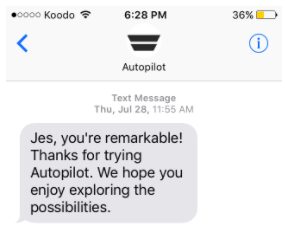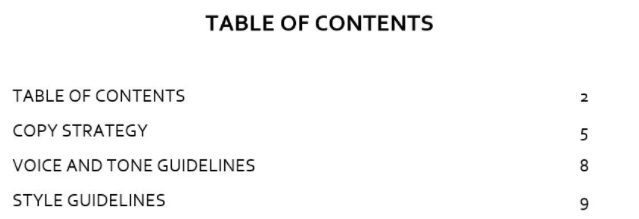November 2, 2016
Create Copy Decks
What is a copy deck, you ask? A copy deck is a document that contains a series of related messages. It provides the infrastructure required to plan (and later write) your copy. It’s a helpful tool for copywriters, marketing managers, and growth marketers creating customer journeys. Strategy copy decks were once used by advertising agencies and freelance copywriters responsible for developing content for their clients’ new or revamped websites. Over the years, they’ve been adapted to serve other purposes (e.g. an email marketing campaign to drive event registration for an annual conference) and fit other contexts.
 (Check out a 10-page sample copy deck)
(Check out a 10-page sample copy deck)
When evaluating whether a copy deck is right for you, consider these questions:
- Will your copy strategy (i.e. purpose, goals, audience) stay the same for the foreseeable future?
- Do you plan to update your messages with fresh content at least once per year?
- Will multiple people contribute to the copy development process?
If you answered yes to any of the above questions, consider using copy decks to structure your copywriting process.
How do copy decks help?
Copy decks help keep your team organized and aligned
Working off of one document—a document that includes relevant background information as well as an agreed upon strategy and brand communication guidelines—helps keep staff on the same page.
Copy decks help you deliver consistent and effective messaging
Brand communication guidelines help staff write consistent messages, while clearly communicated goals and objectives help contributors produce effective messages.
Copy decks help you operate your business more efficiently
Copy decks prevent you from reinventing the wheel year after year. Once you’ve produced a copy deck for one customer journey, you can simply update it the following year to reflect any changes. In other words, copy decks save you time and money while helping your team work more efficiently. Reap these benefits (and more) by following these 5 steps:
Step 1. Plan your copy
The first thing you’ll need to do is develop your copy strategy, otherwise known as your creative brief or copy platform. During this stage, you’ll need to determine:
The purpose of your communication
Why are you communicating with your target audience?
Your objectives and/or goals
What do you want to achieve via these communications?
Your target audience
Who do you want to reach?
Your key messages
What should your audience remember long after each message is received? Hint: Aim for no more than 3 key messages. These are your core ideas as opposed to the details that support your core ideas.
Your communication channels
Which channels will you use to distribute your messages? **Hint: **You can incorporate email, SMS, and direct mail as well as on-site and in-app messages into your customer journey. 
Any supporting information
What information is mission critical? Hint: Follow the example of every good journalist. Seek these fundamental details:
- the what (e.g. a growth marketing conference)
- the when (e.g. February 24, 2017 between 9 AM and 6 PM)
- the where (e.g. The Village, 969 Market Street, San Francisco)
- the why (e.g. relevant statistics, customer testimonials)
- the how (e.g. recipients can buy tickets using this link)
Developing a strategy in advance will help you produce more effective customer journeys.
Step 2. Prepare your structure
Once you’ve finished the planning stage, prepare the structure of your copy deck. It should contain 5 elements:
1. Title page
Your title page should include the following elements:
- Company name (e.g. Autopilot)
- Purpose (e.g. To drive event registrations)
- Individual owner (e.g. Anne Fleshman)
- Other contributors (e.g. Guy Marion, Brian Sun)
- Date last updated (e.g. October 10, 2016)
- Version (e.g. V3)
Why does the title page matter? Because it keeps contributors focused on the task at hand. It also tells viewers who they can contact if they have questions. And long after you’ve moved on to other projects, it reminds you when the copy was last updated.
2. Table of contents
 Your table of contents serves two purposes:
Your table of contents serves two purposes:
- It outlines the document’s contents
- It helps readers navigate the document
When preparing your table of contents, group similar content together. Doing so will help you develop logical sections and subsections that add structure to your copy deck. It will also make your table of contents easier to scan. Pro Tip: You can help readers jump to specific messages without having to scroll through the document by linking to each message from your table of contents.
3. Copy strategy
This section contains a copy of the strategy you worked out in step one.
4. Voice, tone, and style guidelines
These guidelines are a resource for contributors and editors alike. They remind contributors how to convey your brand’s identity. If you haven’t fully grasped these concepts, you’re not alone. Many people struggle to differentiate between a brand’s voice, tone, and style. Here’s a quick overview: Voice (the what) refers to the way you convey your unique brand identity. It includes your brand’s personality, the standard rhythm and pace of your communications, as well as your brand’s preferred vocabulary. Tone (the how) refers to how your brand voice changes in different situations. Think of it this way: The tone you use when providing customer support is different from the tone you use when hosting a podcast. But your identity remains consistent.  Style (the details) refers to your brand’s preferences regarding spelling, when and whether to capitalize certain words, when and whether to use abbreviations, how to punctuate sentences, and the like.
Style (the details) refers to your brand’s preferences regarding spelling, when and whether to capitalize certain words, when and whether to use abbreviations, how to punctuate sentences, and the like.
5. Contents
This section will house your copy. Your goal should be to create a document that’s easy to navigate. With that in mind, keep your contents organized by placing each message on a new page.  At minimum, each page item should include:
At minimum, each page item should include:
- a unique identifier (e.g. 4F)
- the channel of communication (e.g. email)
- the sender of the message (e.g. Guy Marion)
- the message’s intended recipients (e.g. customers located in the San Francisco Bay Area)
- the date and time the message will be sent (e.g. December 1, 2016 at 7:30 AM PST)
- the message
Don’t forget to include a link that takes you back to the table of contents at the bottom of each page. Doing so will make it easier for everyone to skip around the document.
Step 3. Write your copy
Now that your structure is in place, it’s time to write. Each message should include 3 components:
- the key message (e.g. you’re invited to our growth marketing conference)
- any supporting information (i.e. when and where the event takes place, where and how to buy tickets, etc.)
- the call-to-action (e.g. reserve your seat)
 As you write, keep these tips in mind:
As you write, keep these tips in mind:
Write for humans
Using simple language and a conversational tone makes your copy feel approachable.
Serve your audience
Your audience should benefit from every message you send, including marketing and sales messages. You can help educate prospects by including a tip from an expert or a customer review—anything they can learn from. The lesson? Always offer something of value.
Keep it short
Shorter messages tend to perform better, so only include what’s absolutely necessary. That often means restricting yourself to one objective per message (e.g. drive event registrations). If your message is too long, consider splitting it into two shorter messages. For more great tips, check out 7 Copywriting Tips for Growth Hackers, Curated From Experts by Buffer’s Kevan Lee.
Step 4. Get peer feedback
Once you’re happy with the copy, it’s time to ask your colleagues for feedback. Look for peers who’re up to speed with your copy strategy, but haven’t contributed to the writing process. They’re best suited to providing actionable feedback.  Ask each individual the following questions:
Ask each individual the following questions:
- Is the copy clear and concise?
- Am I missing anything critical?
- Should anything be removed?
- Are claims backed up by compelling evidence?
- Are names, titles, and quotes accurate?
Step 5. Create your journey
Congratulations! Your copy deck is complete. Now all you have to do is set up your customer journeys. What process do you follow to ensure your messaging is consistent and effective? Let us know in the comments.













